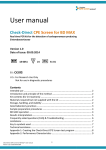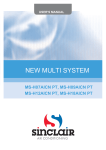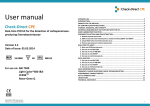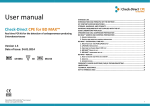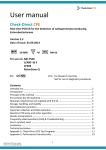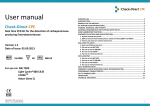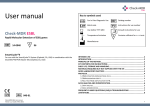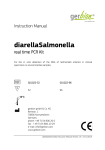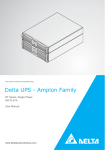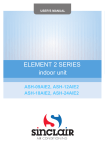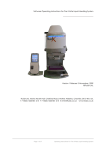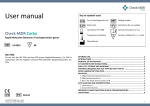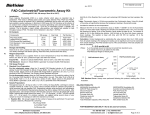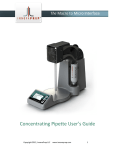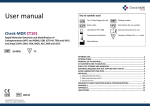Download User manual User manual - Check
Transcript
User manual Check-Direct CPE for SmartCycler Real-time time PCR kit for the detection of carbapenemase-producing carbapenemase producing Enterobacteriaceae Version 1.0 .2014 Date of issue: 15.06.2014 18-0083 48 083-01 EU: U.S.: For Research Use Only Not for usee in diagnostic procedures Contents Intended use ………………………………………………………………………………………………………. 2 Introduction …………………………………………..…………………………………………………………… …………………………………………..…………………………………………………………… 2 Principle of the method ………………………….…………………………………………………………… 2 Kit contents (for 48 reactions) ………………….…………………………………………………………. ………………… ……………………………………………. 2 Materials required but not supplied with the kit ………………………………………………… 2 Storage, handling, and stability ………………………………………………………………………….. 3 Good laboratory practices ………………………………………………………………………………….. ………………………………………………………………………………….. 3 Specimen collection and DNA extraction extraction ……………………………………………………………. 4 Real-time PCR assay and SmartCycler Operation ..……………………………………… ……………………………………………… 4 Results Interpretation ………………………………………………………………………………………… 5 Frequently asked questions (FAQ) & Troubleshooting Tro bleshooting ……………………………………….. 7 Key to symbols used …………………………………………………………………………………………… …………… …………………………………………………………………………… 7 Limitations …………………………………………………………………………………………………………. …………………………… …………………………………………………………………………. 8 Technical assistance …………………………………………………………………………………………… …………… …………………………………………………………………………… 9 Appendix 1: Creating the Check-Direct Check Direct CPE protocol ………………………………………….. 10 Appendix 2: Default settings for analysis ana of Check-Direct Direct CPE results …………………. 10 Appendix 3: Performance characteristics……………………….……………………………………. characteristics……………………….…………………………………… 10 Check-Direct CPE for SmartCycler User manual Version 1.0, Issued 15-06-2014 1 Intended use Check-Direct CPE is a qualitative in vitro diagnostic test for the rapid detection of carbapenemase genes in Enterobacteriaceae. At present the test is validated for bacteria cultured from various clinical specimens. specimens Check-Direct CPE detects the presence of the carbapenemase genes KPC, NDM, VIM, and OXA-48,, presently the primary cause of carbapenemase production in Enterobacteriaceae. Enterobacteriace The assay involves the extraction of DNA from bacterial cells followed by real-time time PCR using the reagents provided with the kit. Check-Direct Direct CPE can be used as an aid to identify, prevent and control carbapenemase--producing Enterobacteriaceae that colonize lonize patients in healthcare settings. Check-Direct Direct CPE is not intended to diagnose infections with carbapenemase-producing carbapenemase Enterobacteriaceae nor to guide or monitor treatment for these infections. Parallel cultures are necessary to recover organisms for epidemiological typing, susceptibility testing and for further confirmatory identification. Introduction The worldwide emergence and dissemination of carbapenem resistance among Enterobacteriaceae is a serious threat to public health. These organisms are associated with high mortality rates and have the potential to spread widely. The most common cause of carbapenem resistance in Enterobacteriaceae is the expression of carbapenemases, i.e. Carbapenemase-Producing Enterobacteriaceae or CPE. CPE have elevated ed or complete resistance to carbapenems and most other β-lactam lactam antibiotics. Presently, Presen the vast majority of CPE are associated with the presence of one of the following plasmid-encoded encoded carbapenemases: KPC (Klebsiella ( pneumoniae carbapenemase), VIM (Verona integron– encoded metallo-β-lactamase), lactamase), NDM (New Delhi metallo-β-lactamase) or OXA-48 48 (Oxacillinase-48). (Oxacillinase Moreover, CPE often have other non-β-lactam lactam resistance determinants resulting in multidrugmultidrug and pandrug--resistant isolates. Check-Direct CPE is a rapid real-time time PCR test for the detection and discrimination of KPC, NDM/VIM and OXA-48. Principle of the method Check-Direct CPE assay is based on specific recognition and amplification of target sequences by PCR, and the simultaneous detection of the accumulation of PCR amplification products by fluorescent DNA D probes. A control DNA molecule, the internal control, is added to the clinical specimen prior to DNA extraction to monitor that DNA extraction and PCR amplification ification were successful. Five molecular beacon probes, labeled with 4 different dyes are used to detect the various carbapenemases and the control DNA. Check-Direct Check Direct CPE discriminates between KPC, NDM/VIM, and OXA-48.. For each of the 4 carbapenemase genes, KPC, OXA-48, OXA 48, NDM and VIM, many gene variants exist. PCR primers and fluorescent probes of Check-Direct Check Direct CPE are selected to target homologous gene segments of these carbapenemase emase genes, and in this way gene variants are reliably detected. Kit contents (for 48 reactions) Components (Mat. No.) Description Storage conditions CPE PCR Mastermix (9-0080) 1 transparent tube and cap 660µl 66 + 4°C CPE solution (9-0081) 1 brown tube (blue inlay ) 140 μl Internal Control (IC) (9-0107) 1 tube (red inlay ) 600 μl Negative control (9-0100) 1 tube (white inlay ) 100 µl KPC positive control (9-0083) 1 tube (green inlay ) 100 μl NDM positive control (9-0085) 1 tube (gold inlay ) 100 μl VIM positive control (9-0084) 1 tube (yellow inlay ) 100 μl - 20°C, store in the dark OXA-48 positive control (9-0086) 1 tube (orange inlay ) 100 μl User manual (9-0088) Leaflet – download from website - Materials required but not supplied with the kit Supplies • • • • • SmartCycler 25 µll Reaction Tubes, cat no 900-0003 900 or 900-0022 Disposable laboratory (powder-free) free) gloves/Lab coat Pipettes & disposable (filter-)) tips for volumes of 10 to 1000 µl PCR-grade water (e.g. Milli-Q Q or aqua bidest) 1.5 ml tubes (“Eppendorf tubes”) Check-Direct CPE for SmartCycler User manual Version 1.0, Issued 15-06-2014 Equipment • • • • • Real-time time PCR instrument: Cepheid SmartCycler 2.0, software version 2.0d Densitometer suitable for bacterial suspensions Mini-centrifuge with rotor for SmartCycler 25 µl Reaction Tubes cat no 900-0021 SmartCycler Tube Rack, cat no 300-0276 Vortex mixer 2 Storage, handling, and stability Check-Direct CPE reagents are shipped cooled. The CPE PCR Mastermix should be stored at +4°C upon receipt. All other reagents should be stored at -20°C 20°C upon receipt. Please visually inspect the box upon initial opening openi to ensure that its contents are intact. The CPE solution should shou not be exposed to more than 12 freeze-thaw freeze cycles. Please contact the Check-Points office at [email protected] support@check if you have any further questions. Store kit reagents at indicated temperature until expiration date. date Good laboratory practices Recommendations for best results • • • • • • The test must be performed by adequately trained personnel. pers Do not use reagents after their expiration date. Before use, thaw frozen reagents completely at room temperature and vortex briefly to obtain a homogeneous solution. After vortexing briefly, spin down the solution to avoid contamination when opening the cap. Follow recommendations for storage, handling and freeze-thaw thaw cycles to preserve the quality of the kit’s reagents. Protect reagents from light to avoid photo-bleaching photo of the dyes. Periodically, verify the accuracy and precision of pipettes, as well as correct functioning and calibration of the instruments. Prevention of contaminations Use separate rooms: a pre-PCR PCR room and a PCR room. • DNA extraction and preparation of the amplification reactions are carried out in the prepre-PCR room. • Incubation in the real-time time PCR thermocycler thermocy is carried out in the PCR room. • Never transfer items from the PCR room to the pre-PCR pre room. To keep laboratory free of PCR product contamination: • Use pipettes with hydrophobic filter tips. • Make sure to always use a new pipette ipette tip when adding solutions, test samples, and controls to wells of a 96-well 96 plate. • Follow proper pipette-dispensing dispensing techniques to prevent aerosols. • Wear clean disposable gloves and clean lab coats for the different steps of the test. • Change gloves whenever henever you suspect that they are contaminated. • Keep the tubes of all kit components and samples closed as much as possible. • Clean the lab benches and all equipment regularly with a 0.5% sodium hypochlorite solution. Users are strongly advised advis to read the full protocol before starting the test Check-Direct CPE for SmartCycler User manual Version 1.0, Issued 15-06-2014 3 Specimen collection and DNA extraction Crude DNA extraction from bacterial cells Important points before starting: DNA extraction is carried out in the pre-PCR pre room. Procedure: 1. Inoculate nutrient agarr plates with the clinical samples or the bacterial strains to be tested and incubate overnight at 37°C. Typical growth media include blood agar, MacConkey agar and Tryptic Soy agar. Bacteria from selective chromogenic plates may also be used. 2. Prepare a bacterial cterial cell suspension of McFarland 0,5 – 1,0 or OD600 0,08 – 0,15 using PCR-grade PCR water (e.g. Milli-Q or bidest water). 3. For each cell suspension, transfer 200 µl to a 1.5 ml Eppendorf tube (preferably safe lock) and add 10 µl of the internal control solution (IC solution, ). Mix briefly. 4. Heat the tubes at 98°C for 10 minutes. After incubation vortex the tubes vigorously for 30 seconds. 5. Centrifuge the tubes in an Eppendorf centrifuge for 2 minutes at maximum speed. 6. Use the supernatant immediately or store stor at +4°C and use within 24 hours. Alternatively, stored at -20°C for longer periods. Positive and negative control preparation To validate the run, perform positive and negative control reactions for each Check-Direct Check Direct CPE PCR run. The positive and negative controls are supplied with the kit. • Positive control(s) One positive control per target is provided with the kit. Each positive control contains the internal control. These controls may be used individually or combined. Refer to step 2.4 of the Real-Time ime PCR preparation for further details. • Negative control(s) Use the negative control () provided in the kit as a sample to validate validat the run. The negative control contains the internal control. We also recommend performing a DNA extraction as specified earlier, with the internal control solution using a sample known to be negative for the test in use (i.e., ( carbapenemase negative sample, or elution buffer). Real-time PCR assay and SmartCycler Operation 1. Multiplex real-time time PCR setup Table 1 presents the multiplex real-time time PCR setup with the targets detected in each detector channel of the SmartCycler System. Table 1: SmartCycler multiplex real-time PCR setup Detector FAM Cy3 Texas Red Cy5 Channel 1 2 3 4 KPC VIM/NDM OXA--48-like I.C.* Target *I.C: Internal Control When the test is performed for the first time create the PCR test program “Check-Direct “Check Direct CPE” as described in Appendix 1. 2. Real-time PCR preparations 2.1 Calculate the number of reactions. Thaw reagents, mix well, spin down and keep on ice. ice. 2.2 Prepare the real-time PCR mix as described in Table 2. 2 Multiply the CPE solution and the CPE PCR Mastermix Masterm by the right number of samples and include 10% surplus to ensure ensure that you have enough reaction mix for all the calculated reactions. 2.3 Pipette 15 µl of qPCR reaction mix to each of the SmartCycler Cycler Reaction Tubes, i.e. Smart-Tubes. Smart Check-Direct CPE for SmartCycler User manual Version 1.0, Issued 15-06-2014 4 2.4 Pipette 10 µl of test sample or control sample to each pre-filled Smart-Tube. (The 4 positive ositive controls may also be combined into a single “mixed positive control” by adding equal volumes of each control up to a volume of 10 μl per reaction,, i.e. 4 x 2.5 µl of each control). control) 2.5 Close the Smart-Tubes and centrifuge for minimum 7 seconds. Check that no air bubbles have accumulated in the optical part of the tubes (see SmartCycler®II SmartCycler Operator Manual). Place lace the tubes in the SmartCycler Tube Rack and transfer the tubes to the PCR room. Table 2: real-time PCR reaction mix setup. Component Volume per reaction CPE PCR Mastermix 12,5 µl CPE Solution () 2,5 µl Total volume 15 µl 3. SmartCycler Operation 3.1 Insert the Smart-Tubes Tubes into the required PCR “Sites” Sites” (reaction chambers) of the SmartCycler. Press the tubes firmly and close each PCR Site. 3.2 Click ck “Create Run” and specify “Run Name”. If needed add remarks in “Notes”. 3.3 Select the Dye Set: “FCTC25”. button. A new window “Select Protocols and Sites” will be displayed in which you 3.4 Click the “Add/Remove Sites” button. need to specify the “Protocol”” and the number of PCR “Sites” for the test procedure. Select “Check-Direct “Check CPE” as the “Protocol” (See See Appendix 1 if not specified). specified) Highlight the “Sites”” in use for the test procedure and press the right arrow. When the Protocol and Sites have been selected click “OK”. 3.5 Enter the sample I.D.’s for every site in the Sample ID column. 3.6 Click the “Start Run” button. 3.7 When the run is completed, discard the Smart-Tubes Smart according to local regulations. Results interpretation Important points before starting:: For a detailed description on how to analyze data, refer to SmartCycler System User’s manual. Default settings tings should be used for analysis of Check-Direct CPE results. Refer to Appendix 2. Always visually inspect the amplification plot for each sample tested versus CT values obtained with the software. 1. Reported results The SmartCycler software reports Result, Re CT value and amplification curves for each detector channel of each specimen tested.. Results are reported in the “Result table” of the “Views” window in the following way: • NEG indicates no amplification was detected for that detector channel, i.e. FAM, FAM, Cy3, TxR and Cy5. CT value of NEG result = 0.00. Amplification curves of samples showing a NEG result and 0.00 CT value must be checked visually. For this purpose click on the “FAM”, “Cy3”, “TxR” or “Cy5” Tab in de “Views” window. • POS indicates that amplification lification was detected for that detector channel, i.e. FAM, Cy3, TxR and Cy5. POS result will indicate a certain CT value. Amplification mplification curves of samples showing a POS result should also be confirmed visually and checked for abnormalities. For example see se Figure 1. • CT values should be interpreted in correlation with the amplification curves curve and according to the interpretation interpreta method outlined in Tables 3 and 4. 2. Interpretation 2.1 Run validation Check the positive and negative control amplification curves. curv Valid runs: • No instruments system failures during the run. • Positive and Negative Controls are within the CT values specified in Table 3. If the CT values of the controls are not as expected refer to FAQ and Troubleshooting “3”. “3” Check-Direct CPE for SmartCycler User manual Version 1.0, Issued 15-06-2014 5 Table 3: Criteria for a valid run with Check-Direct Direct CPE test. test Controls / Expected CT values KPC FAM NDM Cy3 VIM Cy3 OXA-48 TxR IC Cy5 Positive controls Separate 30 ±3 31 ±3 29 ±3 27 ±3 35 ±3 Positive controls Mixed 33 ±3 30 ±3 30 ±3 30 ±3 34 ±3 Negative control 0.00 0.00 0.00 0.00 35 ±3 2.2 Results interpretation If the run is valid,, interpret results as positive, negative or invalid with the CT values obtained for the samples with the guidelines summarized in Table 4. • Positive carbapenemase samples will show a CT value in the FAM, Cy3 and/or TxR channel. Positive carbapenemase samples will also show a CT value in the Cy5 channel if the target has not out competed the internal control (IC) during uring the reaction. reaction Always visually inspect the amplification plot to verify the result. re See Figure 1 as an example. • Negative carbapenemase samples will show no CT value in the FAM, Cy3, and TxR Channel. In the Cy5 Channel, a CT value is expected at 35 ±3. • Samples with a FAM, Cy3 and TxR CT-value of 0.00 (NEG) and with a Cy5 CT value of 0.00 or > 38 indicate that the sample run is invalid, see FAQ and Troubleshooting Troubleshoo 2 to 6. Table 4: Data interpretation guidelines*. KPC, NDM/VIM, OXA-48 CT values YES 0.00 0.00 IC CT values YES or 0.00 35 ±3 0.00 or >38 Interpretation Positive sample Negative sample Invalid * If observed CT values vary significantly from expected CT values , see FAQ and Troubleshooting section. Figure 1: Screenshot of KPC positive sample run in triplicate on the SmartCycler system. Check-Direct CPE for SmartCycler User manual Version 1.0, Issued 15-06-2014 6 Frequently asked questions (FAQ) & Troubleshooting 1. May other specimen preparation and DNA extraction methods be used with Check-Direct Check Direct CPE? Check-Direct Direct CPE test has been optimized using specific swabs and transport medium in combination with the NucliSENS® easyMAG® extraction methods. Thee crude DNA extraction method from bacterial cells specified in this User Manual may also be used. Check-Points Check Points does not guarantee the performance of the test with methods other than those recommended in this manual. 2. The real-time results show no CT values value or interpretation indicating that the sample is invalid. Possible causes and troubleshooting: • The sample DNA was not added to the assay. • The sample DNA tested with Check-Direct Check Direct CPE is negative and the internal control was not added prior to DNA extraction. tion. Please repeat the DNA extraction. • The DNA extraction failed since the internal control was not detected. Please repeat the DNA extraction. • The sample DNA contains contaminants inhibiting the reactions. Please repeat the DNA extraction. • CPE Solution or CPE PCR Mastermix was not added to the assay. Please repeat the test. • Reagent solutions are degraded or may have expired. expired 3. The real-time results show no CT-values values for the positive control or interpretation indicating that sample is invalid. Possible causes ses and troubleshooting: • The positive control solution was not added. Repeat the test. • CPE Solution or CPE PCR Mastermix was not added to the assay. Please repeat the test. • Reagent solutions are degraded or may have expired. 4. Troubleshooting for invalid d result. Repeat the test using the same DNA extract. If invalid results persist, repeat the test by preparing a new DNA extract from the original specimen. Alternatively, repeat the test with a new DNA extraction from a newly collected specimen. 5. Real-time e results show very low fluorescent signals in all samples and detector channels, including the internal control signal. Possible causes and troubleshooting: • The CPE solution containing the fluorescent probes and primers is degraded. Please check expiration expirati date, the number of thaw/freezing cycles that the CPE solution tube has undergone, and if the kit was stored correctly. • The real-time time PCR system may be responsible for these results. Please refer to instrument User’s manual or contact your real-time PCR R instrument local representative. 6. CT values troubleshooting. • Samples with very low CT values and no amplification curves. The manual threshold is too low. Samples showing a CT value <15 and no amplification curve are considered negative. The observed CT value is an artifact of the software analysis: the threshold crosses the background noise of the curve. • Invalid Run: CT values expected for the controls in Table 6 do not match the CT values observed In the experiment. Check that these ese differences are not no due to the threshold being too high or too low. low If changing the threshold does oes not improve the results, go to FAQ 3. to 6. 7. The real-time time PCR instrument gives an error message. Refer to the real-time time PCR instrument user manual or contact the local technical technical support of the real-time real PCR instrument company. 8. I left Solutions (CPE, Internal control, negative, or positive control) out of the -20°C (-4 4˚F) storage. These reagents must be stored at -20°C (-4°F) 4°F) for proper performance of the test. The performance of the product cannot be fully guaranteed if these solutions so were left out of -20°C (-4˚F) ˚F) for more than 24 hours. 9. Duplicate samples tested with Check-Direct Check CPE test did not yield identical results. CT values of identical samples may vary between individual reactions. Large variations, > 2 CT values, suggest pipetting errors or other differences between the duplicate samples. 10. Data Analysis and Interpretation. If you encounter difficulties with the data analysis and interpretation please contact Check-Points Technical Support at [email protected]. Check-Direct CPE for SmartCycler User manual Version 1.0, Issued 15-06-2014 7 Limitations Check-Direct CPE is a DNA-based real-time time PCR assay to detect the presence of the carbapenemase genes KPC, NDM, VIM, and OXA-48 in Enterobacteriaceae. Enterobacteriaceae. The test detects the following carbapenemase gene variants: VIM1-6 & 8-38; OXA-48-162-163-181-232-244-245-247 247-370; NDM1-10 and KPC1-17.. KPC, NDM, VIM, and OXA-48 OXA represent the clinically most prevalent carbapenemases in Enterobacteriaceae in most parts of the world. However, other rare carbapenemases may also be responsible for carbapenemase carbapene production in Enterobacteriaceae and these are not detected by Check-Direct Direct CPE. Carbapenem resistance is caused by carbapenemase production, but also by various other mechanisms. A negative result with Check-Direct Check Direct CPE does not imply that the bacterium bacteri is not carbapenem resistant; it implies that the bacterium is not likely to carry any of the carbapenemase gene variants of KPC, NDM, VIM and OXA-48 detected by Check-Direct Direct CPE. Therefore, the test result of Check-Direct Check Direct CPE should never be used as guidance for therapy. The quality of the input DNA is an important factor for obtaining reliable results with Check-Direct Check CPE. This User Manual describes the use of crude DNA extracts from bacterial cells. This will only work properly using pure water, i.e. MilliQ or aqua bidest, and the specified amount of cells. Other buffers or saline solutions will yield poor results. Other DNA extraction methods have not been tested with Check-Direct Check Direct CPE for SmartCycler and may yield poor results. The assay has been tested sted extensively with samples containing various gram-negative gram negative bacteria, such as Escherichia, Salmonella, Klebsiella, Enterobacter, Citrobacter and Pseudomonas,, with excellent results. However, it may never be excluded that other Gram-negative negative bacteria or certain strains of the above species will yield poor results. Check-Direct Check CPE cannot and does not make any representation or warranty that it is capable of correctly detecting KPC, NDM, VIM, and OXA-48 in all gram-negative negative species, subspecies or types or in in all clinical sample sources. Results may need to be confirmed by additional methodologies in specific cases (e.g. ( for regulatory samples). Due to the high variability of bacterial genomes it is possible that certain subtypes might not be detected. The test te reflects the state of knowledge of Check-Points Points Health B.V. As with other diagnostic assays, the results of this test may only be interpreted in combination with additional laboratory and clinical data available to the responsible person. Use of this assay is limited to appropriately qualified personnel, well-trained trained in performing DNA-based DNA molecular detection methods. Check-Direct CPE for SmartCycler User manual Version 1.0, Issued 15-06-2014 8 Key to symbols used Symbol Definition Symbol Definition For In Vitro Diagnostic Use Negative control Catalog number KPC positive ositive control Batch code VIM positive control IFU number NDM positive control Use before YYYY-MM OXA-48 48 positive control Consult instructions for use Internal control Manufacturer CPE solution Temperature limitation CPE PCR Mastermix Contains sufficient for < n > tests Technical assistance [email protected] +31 317 453 908 Despite the utmost care in the development and preparation of the protocol Check-Points Check cannot take any responsibility for errors, omissions and/or future changes herein. Literature Citation:: When describing a procedure for publication using this product, please refer to it as the Check-Direct Direct CPE. Notice to Purchaser: This product is sold under license from PHRI Properties and may be used under under PHRI Properties patent rights only for human in vitro diagnostics, food testing, veterinary testing, or research. Trademarks FAM is a registered trademarks of Applera Corporation. Corporation Cy3 and Cy5 are registered trademarks of Amersham Biosciences Ltd. Ltd Texas Red® is a registered trademarks of Molecular Probes, Inc. SmartCycler is a registered trademark of Cepheid, Inc. Check-Points Health BV Binnenhaven 5 6709 PD Wageningen The Netherlands Tel: +31 317 453 908 Fax: +31 317 210 147 [email protected] points.com www.check-points.com points.com Check-Direct CPE for SmartCycler User manual Version 1.0, Issued 15-06-2014 9 Appendix 1: Create the Check-Direct Check CPE protocol Important points before starting: Refer to SmartCycler System User’s User’s Manual for detailed instructions on how to operate the SmartCycler System and software version 2.0d. 1. 2. 3. 4. 5. Open the SmartCycler software and click “Define Protocols”. Click “New Protocol” (bottom left). ). Enter Name “Check-Direct CPE”. Enter the parameters for the Check-Direct Check CPE protocol as outlined in Figure A below. When ready click ”Save Protocol”. Figure A : Real-time protocol parameters. Appendix 2: Default settings for analysis of Check-Direct Check Direct CPE results Appendix 3:: Performance Characteristics Characteristi 1. Limit of Detection The analytical limit of detection (LoD) of Check-Direct Check Direct CPE was determined using the individual positive controls 3 supplied with the test. These positive controls contain the target DNA at 10 copies per µl. Serial dilutions were made 4 3 2 of each of the positive controls and 10 , 10 , 10 and 10 copies were added in quadruplicate: a total of 64 reactions following the protocol as described on pages 4 and 5 of this User Manual. 4 3 2 The 10 , 10 and 10 DNA copies were always detected regardless of the target DNA used. Only at 10 copies added as input DNA for the test a difference in LoD was visible, which whic is depicted in the table A. Table A KPC Input DNA copies 10 Success rate 4 out of 4 VIM 10 4 out of 4 Target OXA-48 10 4 out of 4 NDM 10 2 out of 4 Check-Direct CPE for SmartCycler User manual Version 1.0, Issued 15-06-2014 10 2. Specificity 2.1 In silico Specificity The specificity of the Check-Direct Direct CPE real-time real time diagnostic test is ensured by the selection of the correct primers and probes, as well as the selection of stringent reaction conditions. Primers and and probes sequences were validated with in silico analysis. Primers and Probes sequences were designed to specifically identify the gene variants listed in Table B. Primers and Probes sequences were tested for potential homologies with all the gene sequences published by the international gene bank (GenBank®, NIH genetic sequence database) using sequence comparison analysis. Results: No cross homology was found with other organisms for designed primers and probes Table B Gene Variants KPC 1 to 17 NDM 1 to 10 VIM 1 to 6, 8 to 38 OXA 48, 162, 163, 181, 204, 232, 244, 245, 245 247, 370. 2.2 Analytical Specificity The experimental specificity of the Check-Direct Check CPE real-time time diagnostic test was determined by testing the crosscross reactivity with samples containing non-target non organisms. 132 carbapenemase-negative negative strains were used to test the specificity of the Check-Direct CPE real--time test, see bacterial strains listed in Table C. Results: All isolates tested negative with the Check-Direct Check Direct CPE assay and the internal control was detected in all samples. The Check-Directt CPE test showed 100% specificity based on the reference strains tested. Table C Organisms # Organisms # Citrobacter freundii 5 Enterococcus faecalis 2 Campylobacter jejuni 2 Klebsiella oxytoca 1 Enterobacter aerogenes 1 Klebsiella pneumoniae 16 Enterococcus casseliflavus 1 Pseudomonas aeruginosa 2 Enterobacter cloacae 42 Staphylococcus aureus 2 Escherichia coli 51 Salmonella thypimurium 1 Pseudomonas mirabilis 3 Stenotrophomonas maltophilia 2 Serratia marcescens 1 3. Analytical Reactivity To evaluate the analytical reactivity, a retrospective study was performed with 93 bacterial strains of 26 different gram-negative negative species (Table D). The 93 bacterial strains tested with Check-Direct Check Direct CPE were previously identified carbapenemase-positive with th the micro-array micro diagnostics test Check-MDR CT103 (Check-Points Points Heatlth). Results: All 93 bacterial strains were typed correctly for the targeted carbapenemase genes with the Check-Direct Check CPE test. Table D # Check-MDR CT103 19 KPC Check-Direct Direct CPE KPC 16 NDM NDM/VIM 1 NDM+OXA-48 NDM/VIM+OXA NDM/VIM+OXA-48 33 VIM NDM/VIM 1 VIM+OXA-48 NDM/VIM+OXA NDM/VIM+OXA-48 23 OXA-48 OXA-48 Check-Direct CPE for SmartCycler User manual Version 1.0, Issued 15-06-2014 11












